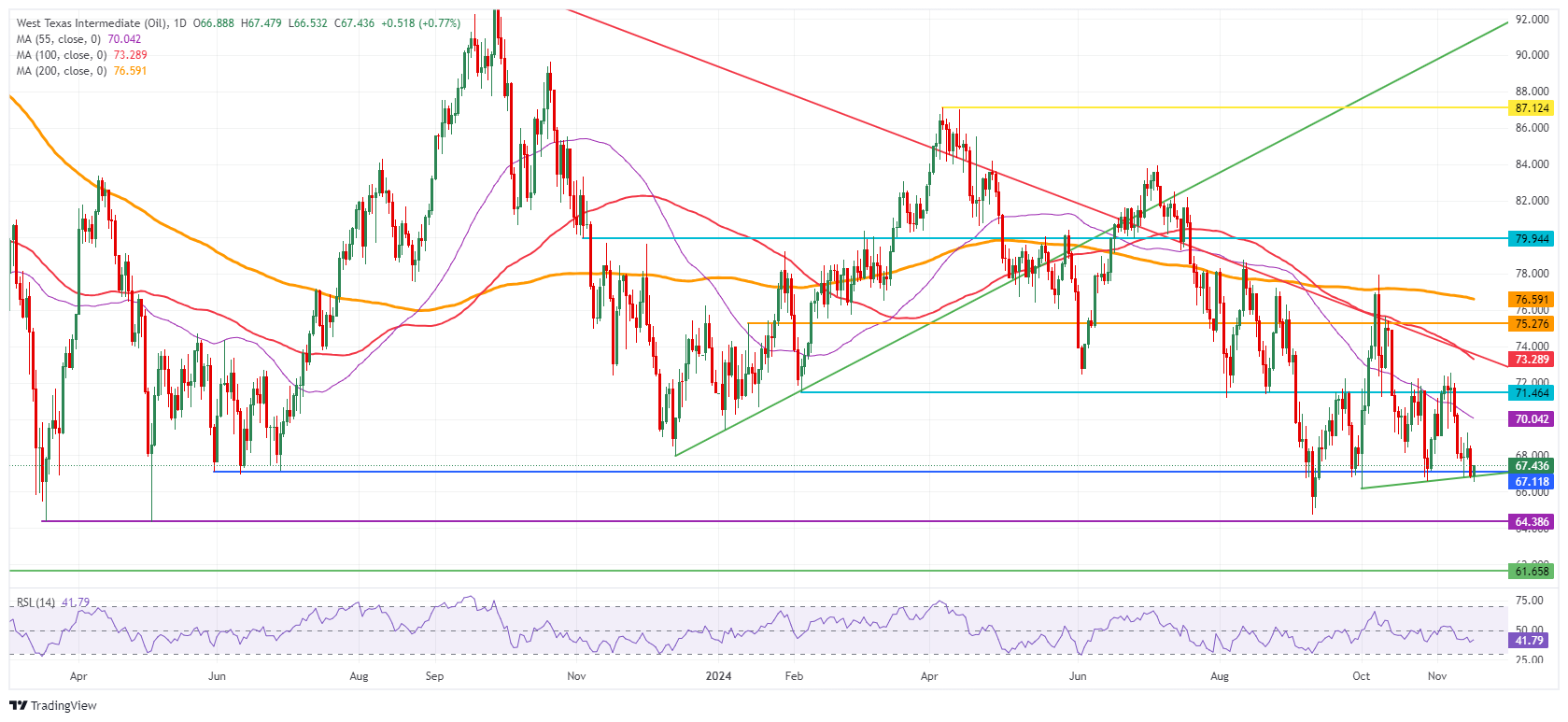Crude Oil sprints near 3% higher on Monday with G20 trying to outpace Trump in a peace deal between Russia and Ukraine

- Crude Oil rallies over 2% with tensions escalating between Russia and Ukraine over the weekend.
- The G20 meeting will include a Ukraine peace deal high on the agenda.
- The US Dollar Index flat on Monday after having printed a fresh one-year high at 107.07.
Crude Oil surges to $69.00 on Monday after tensions escalated in the war between Russia and Ukraine over the weekend. Russia launched a large air strike to hit Ukraine’s power grid, while US President Joe Biden’s administration allowed Kyiv to strike Russian territory with its long-range missiles.
Solutions around the Ukraine situation will be discussed in the G20 meeting starting Monday in Rio de Janeiro, Brazil. With the turn of events since Friday, several parties – even Ukrainian President Vladimir Zelensky himself – called for an end to the war in 2025. A truce or an end to the situation would mean more downturn for Crude, with Russian Oil possibly being accepted again once sanctions and embargoes are lifted under a peace deal.
The US Dollar Index (DXY) is retreating a touch from its fresh one-year high at 107.07 that was printed last week. It looks like markets have repriced all elements from the triumph of President-elect Donald Trump. The focus is shifting back to the Federal Reserve (Fed) and the question if the December rate cut is still a good idea before going into the Trump presidency.
At the time of writing, Crude Oil (WTI) trades at $68.87 and Brent Crude at $72.85
Oil news and market movers: G20 rushes to get a deal done
- The G20 meeting is set to start this Monday in Rio de Janeiro with a peace deal for Ukraine high on the agenda. Over the weekend, the Biden administration delivered a green light for Ukraine to use US missiles beyond Russian borders, seen as a next step in the escalating tensions.
- Vortexa data show that the amount of crude Oil held around the world on tankers that have been stationary for at least seven days fell to 50.97 million barrels as of November 15, 14% less than last week, Bloomberg reports.
- Nigerian business tycoon Aliko Dangote is looking to raise billions of dollars to step up production at his $20 billion oil refinery on the outskirts of Lagos, the Financial Times reports.
Oil Technical Analysis: Sell on rallies
Crude Oil price is still stuck in the same pattern, posting lower highs and a rather flat level on the downside near $65.00-$66.00. A break lower this support area could quickly see a move to $64.38, a fresh low for 2024. The Relative Strength Index (RSI) on the daily chart suggests that there is still room for a push lower.
On the upside, the 55-day Simple Moving Average (SMA) at $70.04 is the first barrier to consider before the hefty technical level at $73.29, which aligns with the 100-day Simple Moving Average (SMA). The 200-day SMA at $76.59 is still quite far off, although it could get tested in case tensions further intensify.
On the other side, traders need to look towards $67.12 – a level that held the price in May and June 2023 – to find the first support together with that small ascending trend line from October. In case that breaks, the 2024 year-to-date low emerges at $64.75, followed by $64.38, the low from 2023.
US WTI Crude Oil: Daily Chart
WTI Oil FAQs
WTI Oil is a type of Crude Oil sold on international markets. The WTI stands for West Texas Intermediate, one of three major types including Brent and Dubai Crude. WTI is also referred to as “light” and “sweet” because of its relatively low gravity and sulfur content respectively. It is considered a high quality Oil that is easily refined. It is sourced in the United States and distributed via the Cushing hub, which is considered “The Pipeline Crossroads of the World”. It is a benchmark for the Oil market and WTI price is frequently quoted in the media.
Like all assets, supply and demand are the key drivers of WTI Oil price. As such, global growth can be a driver of increased demand and vice versa for weak global growth. Political instability, wars, and sanctions can disrupt supply and impact prices. The decisions of OPEC, a group of major Oil-producing countries, is another key driver of price. The value of the US Dollar influences the price of WTI Crude Oil, since Oil is predominantly traded in US Dollars, thus a weaker US Dollar can make Oil more affordable and vice versa.
The weekly Oil inventory reports published by the American Petroleum Institute (API) and the Energy Information Agency (EIA) impact the price of WTI Oil. Changes in inventories reflect fluctuating supply and demand. If the data shows a drop in inventories it can indicate increased demand, pushing up Oil price. Higher inventories can reflect increased supply, pushing down prices. API’s report is published every Tuesday and EIA’s the day after. Their results are usually similar, falling within 1% of each other 75% of the time. The EIA data is considered more reliable, since it is a government agency.
OPEC (Organization of the Petroleum Exporting Countries) is a group of 12 Oil-producing nations who collectively decide production quotas for member countries at twice-yearly meetings. Their decisions often impact WTI Oil prices. When OPEC decides to lower quotas, it can tighten supply, pushing up Oil prices. When OPEC increases production, it has the opposite effect. OPEC+ refers to an expanded group that includes ten extra non-OPEC members, the most notable of which is Russia.
